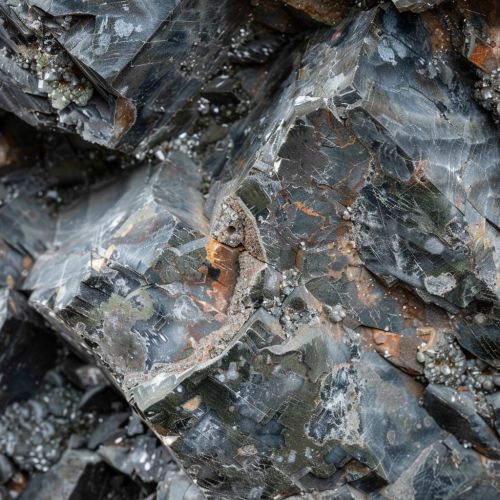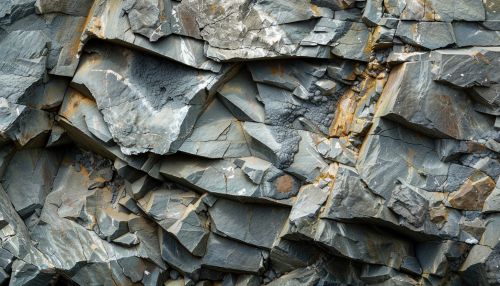Shock-metamorphosed rock: Difference between revisions
(Created page with "== Introduction == Shock-metamorphosed rock refers to rocks that have undergone significant changes in their mineralogical and structural properties due to the passage of shock waves. These shock waves are typically generated by high-energy events such as meteorite impacts, nuclear explosions, or volcanic eruptions. The study of shock-metamorphosed rocks provides valuable insights into the processes and conditions associated with these extreme events. == Formation and...") |
No edit summary |
||
| Line 19: | Line 19: | ||
Existing minerals within the target rock can be transformed into their high-pressure polymorphs due to the extreme conditions generated by shock waves. For example, quartz can be transformed into coesite or stishovite, while graphite can be transformed into diamond. These transformations provide valuable information about the pressure and temperature conditions during the impact event. | Existing minerals within the target rock can be transformed into their high-pressure polymorphs due to the extreme conditions generated by shock waves. For example, quartz can be transformed into coesite or stishovite, while graphite can be transformed into diamond. These transformations provide valuable information about the pressure and temperature conditions during the impact event. | ||
[[Image:Detail-91821.jpg|thumb|center|Close-up of a shock-metamorphosed rock showing high-pressure minerals and planar deformation features.|class=only_on_mobile]] | |||
[[Image:Detail-91822.jpg|thumb|center|Close-up of a shock-metamorphosed rock showing high-pressure minerals and planar deformation features.|class=only_on_desktop]] | |||
== Types of Shock-Metamorphosed Rocks == | == Types of Shock-Metamorphosed Rocks == | ||
Latest revision as of 12:01, 19 June 2024
Introduction
Shock-metamorphosed rock refers to rocks that have undergone significant changes in their mineralogical and structural properties due to the passage of shock waves. These shock waves are typically generated by high-energy events such as meteorite impacts, nuclear explosions, or volcanic eruptions. The study of shock-metamorphosed rocks provides valuable insights into the processes and conditions associated with these extreme events.
Formation and Characteristics
Shock-metamorphosed rocks are formed when a high-energy impact generates shock waves that propagate through the target rock. The intensity of the shock wave decreases with distance from the impact site, resulting in a gradient of metamorphic effects. The primary characteristics of shock-metamorphosed rocks include the presence of high-pressure minerals, planar deformation features (PDFs), and the transformation of existing minerals into their high-pressure polymorphs.
High-Pressure Minerals
One of the most distinctive features of shock-metamorphosed rocks is the presence of high-pressure minerals. These minerals form under the extreme pressures and temperatures generated by shock waves. Common high-pressure minerals found in shock-metamorphosed rocks include coesite, stishovite, and diamond. These minerals are often used as diagnostic indicators of shock metamorphism.
Planar Deformation Features (PDFs)
Planar deformation features (PDFs) are microscopic, planar structures found within minerals such as quartz and feldspar. They are formed by the intense stress and rapid deformation associated with shock waves. PDFs are considered one of the most reliable indicators of shock metamorphism and are often used to identify impact structures.
High-Pressure Polymorphs
Existing minerals within the target rock can be transformed into their high-pressure polymorphs due to the extreme conditions generated by shock waves. For example, quartz can be transformed into coesite or stishovite, while graphite can be transformed into diamond. These transformations provide valuable information about the pressure and temperature conditions during the impact event.


Types of Shock-Metamorphosed Rocks
Shock-metamorphosed rocks can be classified into several types based on their mineralogical and structural characteristics. The most common types include impact breccias, impact melts, and shatter cones.
Impact Breccias
Impact breccias are formed by the fragmentation and mixing of target rock and impactor material during an impact event. They are characterized by a chaotic mixture of angular rock fragments, often cemented together by a fine-grained matrix. Impact breccias can provide valuable information about the composition and structure of the target rock and the impactor.
Impact Melts
Impact melts are formed when the intense heat generated by an impact event causes the target rock to melt. These melts can solidify into a variety of textures, ranging from glassy to crystalline. Impact melts often contain inclusions of unmelted target rock and can provide insights into the thermal conditions during the impact event.
Shatter Cones
Shatter cones are distinctive, conical structures that form in rocks subjected to shock waves. They are characterized by a series of radiating fractures that converge towards a point, giving them a cone-like appearance. Shatter cones are considered diagnostic features of impact structures and are often used to identify ancient impact sites.
Distribution and Occurrence
Shock-metamorphosed rocks are found in a variety of geological settings, including impact craters, volcanic regions, and areas affected by nuclear explosions. The distribution and occurrence of these rocks provide valuable information about the frequency and intensity of high-energy events in Earth's history.
Impact Craters
Impact craters are the most common sites for shock-metamorphosed rocks. These craters are formed by the collision of a meteorite or other celestial body with the Earth's surface. The intense pressure and temperature generated by the impact produce a wide range of shock-metamorphosed rocks, including impact breccias, impact melts, and shatter cones. Notable examples of impact craters with shock-metamorphosed rocks include the Chicxulub crater in Mexico and the Vredefort crater in South Africa.
Volcanic Regions
Volcanic regions can also produce shock-metamorphosed rocks, particularly during explosive eruptions. The rapid release of pressure and the intense heat associated with volcanic explosions can generate shock waves that propagate through the surrounding rock, producing high-pressure minerals and other shock-metamorphic features. Examples of volcanic regions with shock-metamorphosed rocks include the Deccan Traps in India and the Siberian Traps in Russia.
Nuclear Explosion Sites
Nuclear explosions generate intense shock waves that can produce shock-metamorphosed rocks in the surrounding area. These rocks provide valuable information about the effects of nuclear explosions on geological materials and can be used to study the long-term environmental impact of nuclear testing. Notable examples of nuclear explosion sites with shock-metamorphosed rocks include the Nevada Test Site in the United States and the Semipalatinsk Test Site in Kazakhstan.
Analytical Techniques
The study of shock-metamorphosed rocks involves a variety of analytical techniques to identify and characterize the mineralogical and structural changes induced by shock waves. These techniques include petrographic analysis, X-ray diffraction (XRD), and electron microscopy.
Petrographic Analysis
Petrographic analysis involves the examination of thin sections of shock-metamorphosed rocks under a polarizing microscope. This technique allows researchers to identify high-pressure minerals, planar deformation features, and other shock-metamorphic structures. Petrographic analysis is often the first step in the study of shock-metamorphosed rocks and provides valuable information about their mineralogical and structural characteristics.
X-ray Diffraction (XRD)
X-ray diffraction (XRD) is a powerful technique used to identify the mineralogical composition of shock-metamorphosed rocks. By analyzing the diffraction patterns produced by X-rays passing through the rock, researchers can determine the presence of high-pressure minerals and other shock-metamorphic phases. XRD is particularly useful for identifying minerals that are difficult to distinguish using petrographic analysis alone.
Electron Microscopy
Electron microscopy techniques, such as scanning electron microscopy (SEM) and transmission electron microscopy (TEM), provide high-resolution images of the microstructural features of shock-metamorphosed rocks. These techniques allow researchers to examine the fine-scale deformation structures, such as planar deformation features and high-pressure polymorphs, in great detail. Electron microscopy is an essential tool for understanding the mechanisms of shock metamorphism at the microscopic level.
Implications for Planetary Science
The study of shock-metamorphosed rocks has significant implications for planetary science, particularly in the context of impact cratering and the history of the Solar System. Shock-metamorphosed rocks provide valuable information about the frequency and intensity of impact events, the conditions during impacts, and the effects of impacts on planetary surfaces.
Impact Cratering
Impact cratering is a fundamental process in the Solar System, shaping the surfaces of planets, moons, and other celestial bodies. The study of shock-metamorphosed rocks in impact craters provides insights into the mechanics of impact cratering, the energy involved in impacts, and the resulting geological and geochemical changes. This information is essential for understanding the history and evolution of planetary surfaces.
History of the Solar System
Shock-metamorphosed rocks can also provide information about the history of the Solar System, including the timing and frequency of impact events. By dating shock-metamorphosed rocks and identifying the sources of impactors, researchers can reconstruct the impact history of the Earth and other planetary bodies. This information is crucial for understanding the processes that have shaped the Solar System over billions of years.
See Also
- Impact Crater
- High-Pressure Mineral
- Planar Deformation Feature
- Impact Melt
- Shatter Cone
- Electron Microscopy
